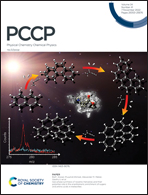Effect of vinylene carbonate on SEI formation on LiMn2O4 in carbonate-based electrolytes†
Abstract
Spinel LiMn2O4 (LMO) is a well-known cathode material for lithium–ion batteries. In order to elucidate the molecular mechanism of the solid electrolyte interface (SEI) formation and the effect of an additive, vinylene carbonate (VC), we systematically studied the spontaneous and electrochemical reactions of solvents and a salt (LiPF6) in electrolytes with LMO in the absence and presence of VC. X-ray photoelectron spectroscopy (XPS) results of the LMO surfaces after soaking in the electrolyte solutions showed that the carbonate solvents as well as VC spontaneously decomposed on the LMO surfaces to form new compounds, such as alcohols, ethers, and carboxylates. The ratio of the produced LiF to MnF2 was similar for both with and without VC. Considering these spontaneously formed initial SEI components, we then investigated the variation of the SEI compositions during the initial electrochemical process until 3.8 V vs. Li+/Li. The role of the additive was studied and found that the electrochemical reaction of VC produced more organic compounds and led to an increase in the LiF/MnF2 ratio of the SEI layer. Based on the hard and soft acid and base theory, we proposed the mechanisms of the SEI formation via spontaneous and electrochemical reactions on the LMO thin film cathode with and without VC.



 Please wait while we load your content...
Please wait while we load your content...